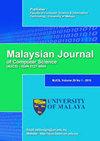DEEP PERONA–MALIK DIFFUSIVE MEAN SHIFT IMAGE CLASSIFICATION FOR EARLY GLAUCOMA AND STARGARDT DISEASE DETECTION
IF 1.2
4区 计算机科学
Q4 COMPUTER SCIENCE, ARTIFICIAL INTELLIGENCE
引用次数: 1
Abstract
Glaucoma and Stargardt’s, an inherited disease predominantly affect the retinal portion of the eye. The diagnosis of Glaucoma in a fundus image is an arduous, time consuming process. There were many research works carried out to detect early stages of Glaucoma and Stargardt’s disease. However, the accuracy, diagnostic time and performance were not improved. To resolve the above said problems, a computational method called Deep Neural Perona–Malik Diffusive Mean Shift Mode Seeking Segmented Image Classification (DNP-MDMSMSIC) is introduced for the early detection of Glaucoma and Stargardt’s disease with retinal fundus images. The DNP-MDMSMSIC method comprises diverse types of layers that support to identify early detection of disease with improved accuracy and less time. Process as explained; initially, numerous qualified retinal images are given as input to the input layer. These input images are transmitted further to the hidden layer 1 to perform image pre-processing. In DNP-MDMSMSIC, Space-Variant Perona–Malik Diffusive Image Preprocessing is carried out to decrease the noise from input image without removing contents like edges, lines, etc., for image interpretation with a higher peak signal-to-noise ratio. This preprocessed image is further processed in the hidden layer 2 where the feature extraction process is performed to extract features like color, texture, and intensity with a higher degree of accuracy. Based on the extracted features, an input feature image gets segmented in hidden layer 3. Mean Shift Mode Seeking Segmentation algorithm is employed to segment the pixels in image space with corresponding feature space points. Then the segmented images are given to the output layer to perform retinal fundus image classification using Bregman Divergence Function. During the image classification, the distance between two segmented regions (i.e., testing image region of particular class and training image region) with convex is measured. In this way, the retinal fundus images get classified with higher accuracy. Experimental evaluation is performed by considering the metrics such as peak signal-to-noise, disease detection accuracy, disease detection time, and error rate corresponding to the number of retina fundus images and image size. DNP-MDMSMSIC method is designed to detect Glaucoma and Stargardt’s disease at an earlier stage with higher accuracy by 8% and less time by 20% with aid of ACRIMA database.深PERONA-MALIK扩散平均移位图像分类在早期青光眼和STARGARDT疾病检测中的应用
青光眼和Stargardt’s是一种遗传性疾病,主要影响眼睛的视网膜部分。眼底图像对青光眼的诊断是一个艰巨而耗时的过程。有许多研究工作是为了检测青光眼和Stargardt病的早期阶段。然而,准确性、诊断时间和性能都没有提高。为了解决上述问题,引入了一种称为深度神经Perona–Malik扩散平均移位模式搜索分段图像分类(DNP-MDMSMSIC)的计算方法,用于视网膜眼底图像对青光眼和Stargardt病的早期检测。DNP-MDMSMSIC方法包括不同类型的层,支持以提高的准确性和更短的时间识别疾病的早期检测。说明的过程;最初,将大量合格的视网膜图像作为输入提供给输入层。这些输入图像被进一步传输到隐藏层1以执行图像预处理。在DNP-MDMSMSIC中,进行了空间变体Perona–Malik扩散图像预处理,以在不去除边缘、线条等内容的情况下降低输入图像的噪声,从而实现具有更高峰值信噪比的图像解释。该预处理图像在隐藏层2中被进一步处理,在隐藏层2执行特征提取处理以更高精度地提取诸如颜色、纹理和强度的特征。基于提取的特征,在隐藏层3中对输入特征图像进行分割。采用均值移位模式搜索分割算法对图像空间中具有相应特征空间点的像素进行分割。然后将分割的图像提供给输出层,以使用Bregman发散函数进行视网膜眼底图像分类。在图像分类过程中,测量具有凸的两个分割区域(即特定类别的测试图像区域和训练图像区域)之间的距离。这样,视网膜眼底图像可以得到更高精度的分类。通过考虑峰值信噪比、疾病检测精度、疾病检测时间和与视网膜眼底图像的数量和图像大小相对应的错误率等指标来进行实验评估。DNP-MDMSMSIC方法是在ACRIMA数据库的帮助下,设计用于早期检测青光眼和Stargardt病,准确率高8%,时间短20%。
本文章由计算机程序翻译,如有差异,请以英文原文为准。
求助全文
约1分钟内获得全文
求助全文
来源期刊

Malaysian Journal of Computer Science
COMPUTER SCIENCE, ARTIFICIAL INTELLIGENCE-COMPUTER SCIENCE, THEORY & METHODS
CiteScore
2.20
自引率
33.30%
发文量
35
审稿时长
7.5 months
期刊介绍:
The Malaysian Journal of Computer Science (ISSN 0127-9084) is published four times a year in January, April, July and October by the Faculty of Computer Science and Information Technology, University of Malaya, since 1985. Over the years, the journal has gained popularity and the number of paper submissions has increased steadily. The rigorous reviews from the referees have helped in ensuring that the high standard of the journal is maintained. The objectives are to promote exchange of information and knowledge in research work, new inventions/developments of Computer Science and on the use of Information Technology towards the structuring of an information-rich society and to assist the academic staff from local and foreign universities, business and industrial sectors, government departments and academic institutions on publishing research results and studies in Computer Science and Information Technology through a scholarly publication. The journal is being indexed and abstracted by Clarivate Analytics'' Web of Science and Elsevier''s Scopus
 求助内容:
求助内容: 应助结果提醒方式:
应助结果提醒方式:


